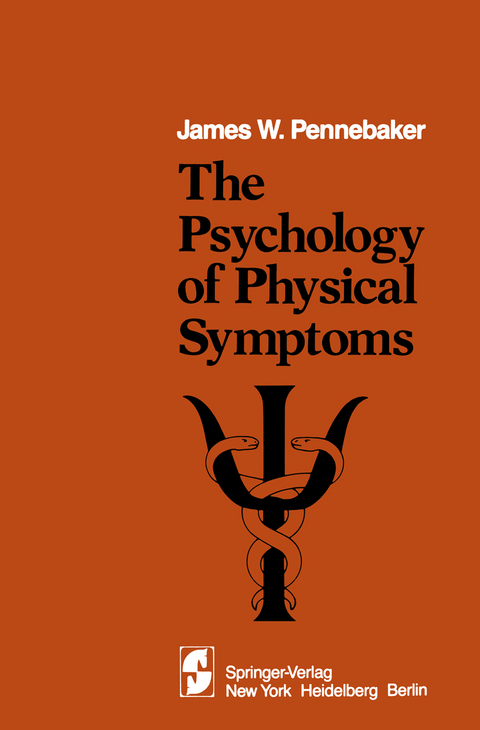
The Psychology of Physical Symptoms
Springer-Verlag New York Inc.
978-1-4613-8198-3 (ISBN)
Physical symptoms are fascinating phenomena to examine. We all experience them, use them as signals to guide our behavior, and usually assume that they accurately represent underlying physiological activity. At the same time, we implicitly know that bodily sensations are often vague, ambiguous, and subject to a variety of interpretations. It is not surprising, then, that there is often a disparity between what we think is going on in our bodies and what is objectively occurring. In short, phenomena such as physical symptoms are the stuff of psychology. My own research into physical symptoms started by accident several years ago. In a hastily devised experiment dealing with the effects of noise on behavior, I had to write a post-experimental questionnaire that would be long enough to allow the experimenter time to calibrate some equipment for a later portion of the study. I included some physical symptoms on the questionnaire as fillers. The experiment was a total failure, with the exception of the symptom reports. People's perceptions of symptoms were easily influenced by our manipulations, even though their actual physiological state had not changed. And so began the present inquiry. Despite the pervasiveness, importance, and sheer amount of time and money devoted to discussing and curing common physical symptoms and sensations, very little empirical work has been devoted to examining the psychological and perceptual factors related to sensory experience. Occa sional papers have tested a specific theory, such as cognitive dissonance, wherein physical symptoms served as an interesting dependent measure.
1 Introduction and Overview.- Boundary Conditions Surrounding Symptom Reporting.- Demographic and Cultural Comparisons.- Experimental and Theoretical Approaches.- Plan of This Book.- 2 Perceptual Processes I: Competition of Cues.- The Perceptual Process.- Orienting and Competition of Cues.- Concluding Remarks.- 3 Perceptual Processes II: Schemas, Selective Search, and Inference.- Selective Monitoring of Specific Sensations.- Selective Monitoring of Categorical or Higher Order Body States.- Inference of Physical Symptoms.- Generality of Schema-Directed Search.- Implications and Conclusions.- 4 Accuracy of Perception Relative to Physiological State.- Measurement of Accuracy: Between-Subjects Versus Within-Subject Approaches.- Situational and Dispositional Factors and Accuracy.- Is Accuracy Unidimensional?.- Conclusions and Future Directions Concerning Accuracy.- 5 Cognitive Organization I: Emotions.- Symptoms and Emotions: Perceptual Specificity.- Causal and Temporal Relationships Between Symptoms and Emotions.- Physiological Search for the Symptom—Emotion Link.- Toward an Understanding of the Emotion—Symptom Link.- Summary.- 6 Cognitive Organization II: Blood Pressure and Blood Glucose.- Blood Pressure and Blood Glucose Research Projects.- Bases of Cognitive Organization: Through the Looking Glass.- Conclusions and Implications.- 7 Personality and Developmental Correlates.- Measurement and Construct Validity of Symptom Reporting.- Personality Correlates of Symptom Reporting.- Habits and Daily Behaviors of the Symptom Reporter.- Developmental Issues in Symptom Reporting.- Composite Picture of the Symptom Reporter.- 8 Summary and Conclusions.- Adaptive and Functional Bases of Symptoms.- Applications of Symptom Research.- Current Problems and Future Directions.-Appendix A Symptom/Emotion Checklist: A State Measure.- Sample Symptom—Emotion Checklist.- Measurement Parameters of Checklist.- Appendix B The PILL: A Trait Measure.- The Pennebaker Inventory of Limbic Languidness.- Measurement Parameters of the PILL.- References.- Author Index.
| Zusatzinfo | 197 p. |
|---|---|
| Verlagsort | New York, NY |
| Sprache | englisch |
| Maße | 155 x 235 mm |
| Themenwelt | Sachbuch/Ratgeber ► Natur / Technik ► Garten |
| Geisteswissenschaften ► Psychologie ► Klinische Psychologie | |
| Medizin / Pharmazie ► Medizinische Fachgebiete ► Psychiatrie / Psychotherapie | |
| Schlagworte | Psychology • Psychosomatische Erkrankung |
| ISBN-10 | 1-4613-8198-3 / 1461381983 |
| ISBN-13 | 978-1-4613-8198-3 / 9781461381983 |
| Zustand | Neuware |
| Haben Sie eine Frage zum Produkt? |
aus dem Bereich


